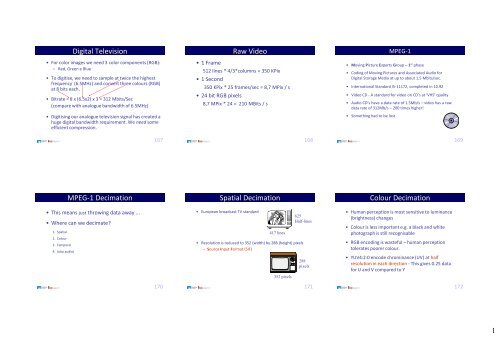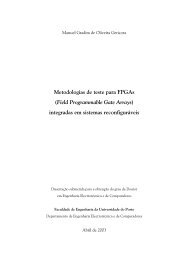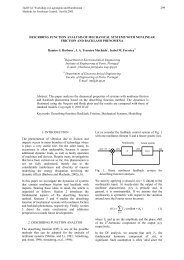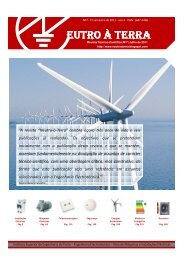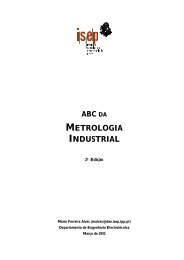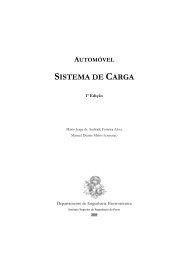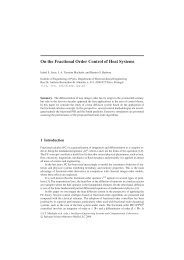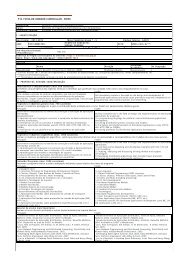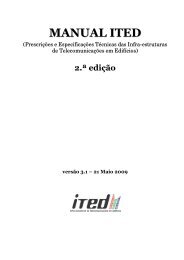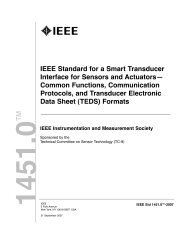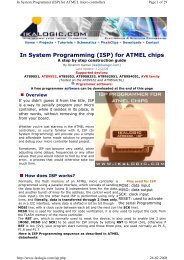1 Digital Television Raw Video MPEG-1 Decimation Spatial ...
1 Digital Television Raw Video MPEG-1 Decimation Spatial ...
1 Digital Television Raw Video MPEG-1 Decimation Spatial ...
Create successful ePaper yourself
Turn your PDF publications into a flip-book with our unique Google optimized e-Paper software.
<strong>Digital</strong> <strong>Television</strong><br />
• For color images we need 3 color components (RGB):<br />
– Red, Green e Blue<br />
• To digitise, we need to sample at twice the highest<br />
frequency (6.5MHz) and convert three colours (RGB)<br />
at 8 bits each.<br />
• Bitrate = 8 x (6.5x2) x 3 = 312 Mbits/Sec<br />
(compare with analogue bandwidth of 6.5MHz)<br />
• Digitising our analogue television signal has created a<br />
huge digital bandwidth requirement. We need some<br />
efficient compression.<br />
<strong>Raw</strong> <strong>Video</strong><br />
• 1 Frame<br />
512 lines * 4/3*columns = 350 KPix<br />
• 1 Second<br />
350 KPix * 25 frames/sec = 8,7 MPix / s<br />
• 24 bit RGB pixels<br />
8,7 MPix * 24 = 210 MBits / s<br />
<strong>MPEG</strong>-1<br />
• Moving Picture Experts Group – 1 st phase<br />
• Coding of Moving Pictures and Associated Audio for<br />
<strong>Digital</strong> Storage Media at up to about 1.5 Mbits/sec.<br />
• International Standard IS-11172, completed in 10.92<br />
• <strong>Video</strong> CD - A standard for video on CD’s at ‘VHS’ quality<br />
• Audio CD’s have a data rate of 1.5Mb/s – video has a raw<br />
data rate of 312Mb/s – 200 times higher!<br />
• Something had to be lost<br />
167<br />
168<br />
169<br />
<strong>MPEG</strong>-1 <strong>Decimation</strong><br />
• This means just throwing data away ...<br />
• Where can we decimate?<br />
1. <strong>Spatial</strong><br />
2. Colour<br />
3. Temporal<br />
4. (also audio)<br />
<strong>Spatial</strong> <strong>Decimation</strong><br />
• European broadcast TV standard<br />
417 lines<br />
• Resolution is reduced to 352 (width) by 288 (height) pixels<br />
– Source Input Format (SIF)<br />
352 pixels<br />
625<br />
Half-lines<br />
288<br />
pixels<br />
Colour <strong>Decimation</strong><br />
• Human perception is most sensitive to luminance<br />
(brightness) changes<br />
• Colour is less important e.g. a black and white<br />
photograph is still recognisable<br />
• RGB encoding is wasteful – human perception<br />
tolerates poorer colour.<br />
• YUV4:2:0 encode chrominance (UV) at half<br />
resolution in each direction - This gives 0.25 data<br />
for U and V compared to Y<br />
170<br />
171<br />
172<br />
1
Temporal <strong>Decimation</strong><br />
<strong>Decimation</strong> – The Result<br />
<strong>Spatial</strong> Compression<br />
• Three standards for frame rate in use today<br />
– Cinema uses 24 FPS<br />
– European TV uses 25 FPS<br />
– American TV uses 29.97 FPS<br />
• Lowest acceptable frame rate is 25 FPS so little<br />
decimation can be achieved for <strong>Video</strong> CD<br />
• Interlacing is dropped giving 25 full frames per<br />
second.<br />
• <strong>MPEG</strong>-1 does allow much lower frame rates e.g.<br />
for internet video – but quality is reduced<br />
• After throwing away all this information, we still<br />
have a data rate of (assuming 8 bits per YUV):<br />
– Y = (352*288) * 25 * 8 = 20.3 Mb/s<br />
– U = (352/2 * 288/2) * 25 * 8 = 5.07 Mb/s<br />
– V = (352/2 * 288/2) * 25 * 8 = 5.07 Mb/s<br />
– TOTAL (for video) = 30.45 Mb/s<br />
– <strong>MPEG</strong> 1 audio runs at 128Kb/s<br />
– <strong>Video</strong> CD - Target is 1.5Mb/sec<br />
– Space for video = 1.5 – 0.128Mb/s = 1.372Mb/s<br />
• So now use compression to get a saving of 22:1<br />
• A video is a sequence of images – and images<br />
can be compressed<br />
• JPEG uses lossy compression – typical<br />
compression ratios are 10:1 to 20:1<br />
• We could just compress images and send these<br />
• Time does not enter into the process<br />
• This is called intra-coding (intra = within)<br />
173<br />
174<br />
175<br />
<strong>Spatial</strong> Compression<br />
Temporal Compression<br />
Difference Coding<br />
• Very similar to JPEG<br />
• Image divided into 8 by 8 pixel<br />
sub-blocks<br />
• Number of blocks = 352/8 by<br />
288/8 = 44 by 36 blocks<br />
• Each block DCT coded<br />
• Quantisation - dropping lowamplitude<br />
coefficients<br />
• Huffman coded<br />
• This produces a complete<br />
frame called an Intra frame (I)<br />
176<br />
• <strong>Spatial</strong> compression does<br />
not take into account<br />
similarities between<br />
adjacent frames<br />
• Talking Heads -<br />
Backgrounds don’t change<br />
• Consecutive images<br />
(1/25th second apart) are<br />
very similar<br />
• Just send the difference<br />
between adjacent frames<br />
177<br />
• Only send difference between<br />
this frame and previous frame<br />
• Result is very sparse – high<br />
compression now possible using<br />
block-based DCT as before<br />
178<br />
2
Difference Coding<br />
Difference Coding<br />
Group of Pictures - GOP<br />
• Using the previous<br />
frame and the<br />
difference frame we<br />
can recreate the<br />
original – this is called a<br />
predicted frame (P)<br />
• Difference coding is good for<br />
‘talking heads’<br />
• Problem with P frames is any errors are propagated (like<br />
making copies of copies of copies) - so we regularly send full<br />
(I) frames to eliminate errors<br />
• Every 0.5 seconds approx we send a full frame (I)<br />
• This recreated frame<br />
can then be used to<br />
form the next frame<br />
and the process is<br />
repeated.<br />
• Not good for scenes with lots of<br />
movement<br />
I P P P P P P P P P P P I P P P P P P P P P P P I P P<br />
GOP <br />
• In the event of an error, data stream is resynchronised after<br />
12/25th of a second (or 15/30th for USA)<br />
179<br />
180<br />
• The sequence between ‘I’s is called a Group Of Pictures<br />
181<br />
Motion Compensation<br />
Motion Compensation<br />
Motion Compensation<br />
• Difference coding is good, but<br />
often an object will simply change<br />
position between frames.<br />
• <strong>Video</strong> is three-dimensional<br />
(X,Y, Time)<br />
• DCT coding reduces information<br />
in X and Y<br />
• Stationary objects do not move<br />
in time<br />
• Called Motion Compensation since we actually adjust the position of the<br />
object to compensate for the movement<br />
• DCT coding not as good as for<br />
‘sparse’ difference image.<br />
• Motion compensation takes<br />
time into account<br />
• No need to code the image of the object – just send a motion<br />
vector indicating where it has moved to<br />
182<br />
183<br />
184<br />
3
Motion Compensation – The Problems<br />
• Objects rarely move and retain their shape<br />
• If object moves and changes shape a little:<br />
– Find movement and send motion vector<br />
– Subtract moved object in last frame from object in new frame<br />
– DCT code the difference<br />
• But what is an object? We have an array of pixels.<br />
• Could try and segment image into separate objects – but<br />
very intense processing!<br />
• Simple option - split image up into blocks that don’t<br />
correspond to ‘objects’ in the image – macroblocks<br />
185<br />
Macroblocks<br />
• Macroblocks can be any shape or size<br />
– If small, then we need to send lots of vectors<br />
– If large, then we are unlikely to find a matching macroblock<br />
• <strong>MPEG</strong>-1 uses a 16 by 16 pixel macroblock<br />
• Each macroblock is the unit for motion compensation<br />
– Find macroblock in previous frame similar to this one<br />
– If match found, send motion vector<br />
– Subtract this macroblock from previous displaced macroblock<br />
– DCT code the difference<br />
• If no matching block found, abandon motion compensation and<br />
just DCT code the macroblock<br />
186<br />
<strong>MPEG</strong>-1 Compression<br />
• Eyes - difference data DCT coded<br />
• Ball - motion vector coded, actual image<br />
data not coded<br />
• Rabbit - Intra coded with no temporal<br />
compression<br />
• Coding method varies between<br />
macroblocks<br />
187<br />
Additional <strong>MPEG</strong>-1 complexities<br />
Encoding<br />
Encoding<br />
• Motion compensation allows significant<br />
data reduction….. but only takes into<br />
account time moving forward<br />
Source material<br />
(video + audio)<br />
Demuxing separates streams<br />
Source material<br />
(video + audio)<br />
• Bidirectional frames (B) - predicted from<br />
past and future frames<br />
<strong>Raw</strong> video<br />
Compressed<br />
video<br />
<strong>Raw</strong> audio<br />
Compressed<br />
audio<br />
Encoding compresses streams<br />
<strong>Raw</strong> video<br />
Compressed<br />
video<br />
<strong>Raw</strong> audio<br />
Compressed<br />
audio<br />
Metadata<br />
Title, Artist, ISRC<br />
Author, Publisher<br />
Muxing combines streams again<br />
Single video file<br />
Single video file<br />
188<br />
189<br />
190<br />
4
Especificação <strong>MPEG</strong>-2<br />
Codec name<br />
<strong>MPEG</strong>-1<br />
<strong>MPEG</strong>-2<br />
<strong>MPEG</strong>-4 ASP<br />
H.263<br />
H.264<br />
WMV<br />
VC-1<br />
Theora<br />
Inventor<br />
<strong>MPEG</strong> WG<br />
<strong>MPEG</strong> WG<br />
<strong>MPEG</strong> WG<br />
<strong>MPEG</strong> WG<br />
<strong>MPEG</strong> WG<br />
Microsoft<br />
Microsoft<br />
On2, Xiph.org<br />
Popular usage<br />
VCD<br />
DVD<br />
Movie pirates<br />
YouTube, Google <strong>Video</strong><br />
YouTube HD, iTunes, Blu-Ray<br />
Microsoft world domination<br />
Blu-Ray<br />
Free Software hippies<br />
Patent-free?<br />
No<br />
No<br />
No<br />
No<br />
No<br />
No<br />
No<br />
Yes*<br />
Codec name<br />
<strong>MPEG</strong>-1<br />
<strong>MPEG</strong>-2<br />
<strong>MPEG</strong>-4 ASP<br />
H.263<br />
H.264<br />
WMV<br />
VC-1<br />
Theora<br />
OSS tools<br />
ffmpeg, MP1E<br />
ffmpeg, mpeg2enc<br />
ffmpeg, Xvid<br />
ffmpeg<br />
x264<br />
none<br />
none<br />
oggenc, Thusnelda<br />
Non-OSS tools<br />
QuickTime<br />
Compressor, Sonic, TMPGEnc<br />
DivX, 3ivX<br />
Adobe Premiere<br />
Adobe Media Encoder, Apple Compressor, On2<br />
Flix Pro, Sorenson Squeeze, Telestream<br />
Windows Media Encoder, Expression Encoder<br />
Windows Media Encoder, Compressor, Squeeze<br />
none<br />
• Conjunto de 10 especificações<br />
• ISO/IEC:<br />
– 13818-1 Systems.<br />
– 13818-2 <strong>Video</strong> Coding.<br />
– 13818-3 Audio Coding.<br />
– 13818-6 Data Broadcast and DSMCC.<br />
– 13818-7 Advanced Audio Coding (AAC).<br />
Dirac<br />
BBC<br />
HDTV broadcast<br />
Yes*<br />
Dirac<br />
dirac-research,<br />
Schroedinger<br />
none<br />
191<br />
192<br />
193<br />
<strong>MPEG</strong>-ES<br />
• Elementary Stream (ES) é um conjunto de<br />
bytes (fluxo de dados) de um tipo de<br />
dados específico.<br />
– Áudio.<br />
– Vídeo.<br />
– Dados<br />
194<br />
<strong>MPEG</strong>-TS<br />
ES ES ES ES ES ES ES<br />
195<br />
Packetized Elementary Stream<br />
• Os fluxos de dados (ES) são divididos em<br />
pacotes.<br />
• Ao conjunto de pacotes chama-se<br />
Packetized Elementary Stream (PES).<br />
• A cada pacote é adicionado um<br />
cabeçalho.<br />
• Isso permite:<br />
– Detecção de erros<br />
– Multiplexação dos dados<br />
196<br />
5
Multiplexação <strong>MPEG</strong>-2<br />
• Existem dois processos de multiplexação:<br />
– Program Stream<br />
– Transport Stream<br />
Program Stream<br />
• Apenas um programa é multiplexado.<br />
– Conjunto de ES que têm um forte<br />
acoplamento temporal.<br />
• O tamanho dos pacotes PES são variáveis<br />
e podem ser muito grandes.<br />
– Mais difícil de decodificar devido a variação<br />
de tamanho dos pacotes.<br />
– Ideal para ser usado num ambiente<br />
robusto.<br />
Onde se usa Program Stream?<br />
• Ideal para ser usada num ambiente robusto.<br />
197<br />
198<br />
199<br />
Program Stream<br />
• O tamanho dos pacotes PES são variáveis<br />
e podem ser muito grandes.<br />
– Num filme, as partes lentas têm menos<br />
pacotes de vídeo do que as partes com<br />
muita ação.<br />
– Então a velocidade de transmissão varia de<br />
acordo com o tipo de vídeo.<br />
• Para o DVD é fácil alterar a velocidade de leitura<br />
do disco.<br />
200<br />
Transport Stream<br />
• Um ou mais programas podem ser<br />
multiplexados em conjunto.<br />
• O tamanho do pacote é constante. Ideal<br />
para ambientes não robustos:<br />
• Fácil de detectar o início e fim do pacote.<br />
– Mais fácil de detectar perda de dados.<br />
– Mais difícil de desmultiplexar devido à<br />
presença de vários programas.<br />
201<br />
Transport Stream<br />
• Pacotes do tamanho de 188 bytes.<br />
– 4 bytes de cabeçalho<br />
• Todos os pacote começam com 0x47<br />
– Fácil de detectar o início do pacote.<br />
• Cada pacote que carrega um determinado<br />
ES tem o mesmo PID.<br />
• Cada pacote tem um contador para que<br />
se detecte perda de pacotes.<br />
202<br />
6
<strong>MPEG</strong> - TS<br />
H.264 Motion Estimation<br />
Multiple Reference Frames<br />
H.264 Transform<br />
203<br />
204<br />
205<br />
H-264 Quantization<br />
FFmpeg<br />
FFmpeg<br />
• www.ffmpeg.org<br />
• Cross-platform, OpenSource (GPL or LGPL).<br />
• Convert and stream audio and video.<br />
• Can grab from a live audio/video source.<br />
• Includes libavcodec, used by many video<br />
players/encoders:<br />
– mplayer , VLC, xine, transcode, …<br />
206<br />
207<br />
208<br />
7
FFmpeg components<br />
• ffmpeg<br />
– command line tools to convert one video file format to another.<br />
• ffserver<br />
– HTTP and RTSP multimedia streaming server for live broadcasts.<br />
• ffplay<br />
– is a simple media player based on SDL and FFmpeg libraries.<br />
• ffprobe<br />
– command line tool to show media information.<br />
• libavcodec<br />
– library containing all the FFmpeg audio/video encoders and decoders<br />
• libavformat<br />
– is a library containing demuxers and muxers for audio/video containers.<br />
• libavutil<br />
– …<br />
libav<br />
• http://libav.org/<br />
• Forked from FFmpeg on Mar.2011<br />
• Convert and stream audio and video.<br />
• Can grab from a live audio/video source.<br />
• Includes libavcodec<br />
209<br />
210<br />
8


